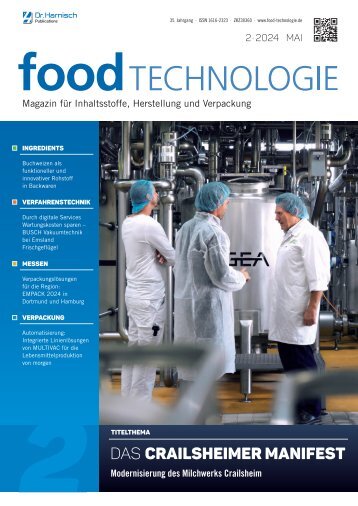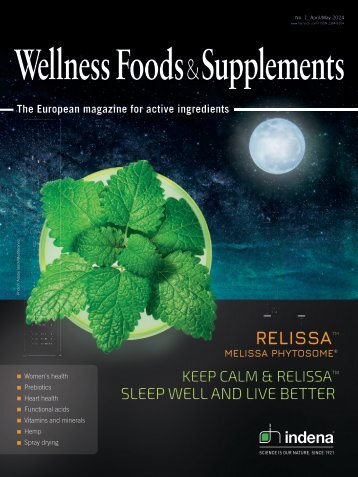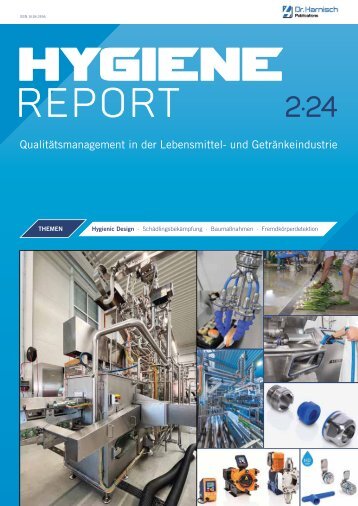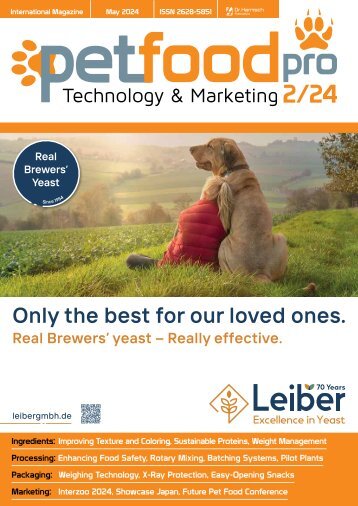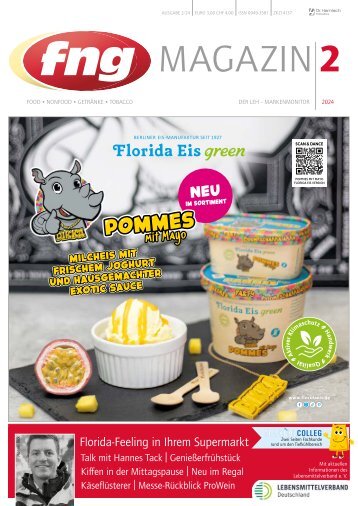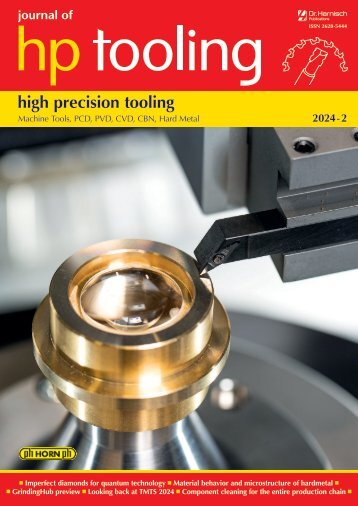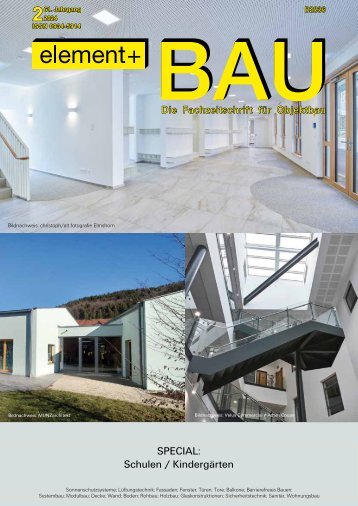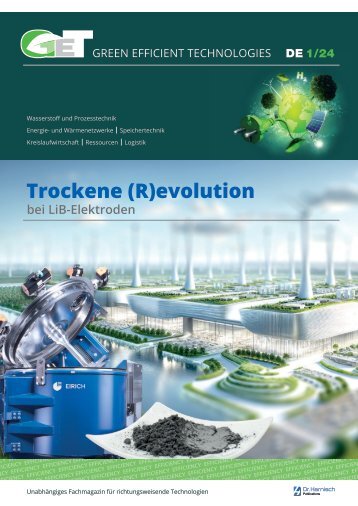food Marketing & Technology 4/2021
- Text
- Harnischcom
- Protein
- Flavor
- Solutions
- Processing
- Consumers
- August
- Ingredients
- Packaging
- Products
- Marketing
Processing temperature
Processing temperature sensor TE2 points into a relevant zone at the middle of the tank with 20-30cm ingression depth. This shall prevent to pick the temperature from an outer layer of caustic that is not representative. As the acid tank mostly operates at room temperature, there is neither isolation nor temperature measurement. All tanks have a low level detection as final warning to be empty, but also a top level sensor that protects the vessel against mechanical damage. The level of caustic is measured with a hydrostatic pressure sensor PBMH. The available amount of acid is in this example controlled with the radar sensor RR30. It could also be an ultrasonic level sensor UNAM if there is no foam, stream or uneven surface bothering the signal. The level measurements help to ensure that for the next cleaning cycle the required amount of cleaning agent is available. The limit switches and pump protection are done with CleverLevel sensors. The LBFS is the basic solution in the dedicated tanks. The PL20H sensors are used where flexibility of detecting completely different liquids is important. Another strength is the choice to either detect or neglect foam. The quality measurement point is supported with the EMF CombiFlow PF75H. As all sensors discussed here, the EMF is designed following the requirements of 3A and EHEDG. This robust and fully stainless steel made sensor enables controlling the velocity on a much higher level than a calorimetric sensor. Like the CombiLyz AFI4 it is equipped with the Baumer DFON graphical display. This does not only support the operator with good readable large figures, but also changes color when the value is out of the desired range. Simple set up and operation come along with both. The temperature sensor PT20H may not be able to utilize the fastest t90 time on the market in this application, but it will support the entire system with a high class signal. In this set up, the sensors allow to run the system directly on the spot, saving time, energy and water with high class signals as no safety margin need to be involved. Full automatic set up At the final stage the CIP operation and documentation will be completely automated. This includes not only the cleaning. As energy monitoring gains more importance since a decade, also a smart option to monitor the heat consumption for each cleaning cycle is a valuable investment. In this example the FlexFlow PF20H measures temperature and volume of the hot water supply of the heat exchanger. The data can be used to benchmark different cleaning cycles, but also to report the value for a carbon footprint. The described system also includes the automated dosing of cleaning agents and composites, using the very compact CombiFlow PF55S. The electromagnetic flow meter ensures exact dosing and as well here, the opportunity to record the amount of concentrates used for every cleaning cycle. The content of the concentrate canister can be measured form the outside with capacitive sensors CFDK25. To protect the environment, the system usually will be installed in a sealed basin. Leakages rinsing into this basin the will be detected with either a CleverLever PL20H or with an optical switch type FFAM installed in the lowest point of the system. Pic 3: Standard CIP system 36 food Marketing & Technology • August 2021
Processing PP20H pressure sensors installed on the way to and on the line from the cleaned process, will supply the valuable information if leakages appear or the system gets blocked at a certain stage. Basics: All three described systems supply the user with the necessary safety that the cleaning cycle worked in the defined frame. High quality cleaning is not a question of investment. Also simple systems support both, cleaning and documentation to prove the quality promised was fulfilled. The shown solutions follow a concept that allows to grow with the tasks. All the sensors come with the hygienic and food contact materials certificates. 3A, FDA and EHEDG are the basic requirements they fulfill on the wetted parts. The housings are made from stainless steel and used with the suitable connector, supply IP 69 ingression protection. Not only to ensure food safety, but also to save energy, water, cleaner and time, the hygienic design plays a major role. Baumer supplies not only dedicated standard process adapters, but offers with the Baumer Hygienic Connection as well a simple, but in the daily operation, high end solution for flush mounted sensor integration to the product line. The DFON display is another standard part we use with a variety of flow, temperature, pressure and conductivity sensors gathered in our CombiSeries. Simple handling and economical spare part stocking follow from both standard technologies. Summary: Size does matter, if it come to installation costs. But size does not have to matter when we consider food safety and efficient CIP cleaning. Baumer supplies the technology from very simple systems up to the full blown automation systems with the same level of professional automation and traceability. The sensors are designed to perform in this environment and ensure long lasting good results. One stop shop for all required technologies enables to create a robust, reliable, easy to handle system that suits exactly to the need of the operation and documentation. fmt Pic 4: Example of a fully automated CIP system Expand the possibilities of autonomous material transport Contact us for proofof-concept testing! Meet OMRON’s family of autonomous mobile robots. You don’t just get a robot - you get a total solution. Our family of mobile robots can safely and efficiently transport a wide range of payloads—from lightweight tasks of 60kg all the way up to 1500kg, even capable to replace forklifts. They can be deployed quickly in stand-alone warehouse applications, as well as integrated into a total automation concept that combines motion, safety, vision, control and robotics, providing a complete solution from one source. +44 (0)1908 258258 oeeuk_sales@omron.com industrial.omron.eu/mobilerobots Key No. 100637 food Marketing & Technology • August 2021 37 mobile_robot_family_c_102,5x148,5mm_ad_en_01_d02.indd 1 07-07-21 16:29
- Seite 1 und 2: 4/21 Vol. 35 • 31377 ISSN 0932-27
- Seite 3 und 4: Editorial Everyone’s Nutrition is
- Seite 5 und 6: Vol. 35 • 31377 ISSN 0932-2744 4/
- Seite 7 und 8: Cover Story potato and corn starch,
- Seite 9 und 10: Ingredients The leading in-person a
- Seite 11 und 12: Ingredients Author: Carolina Diaz Q
- Seite 13 und 14: Ingredients The dairy health trend
- Seite 15 und 16: Ingredients Reformulation: the Cham
- Seite 17 und 18: Ingredients “Veganizing formulati
- Seite 19 und 20: Ingredients Global Alternative Prot
- Seite 21 und 22: Ingredients 7-9 NOV 2021 DUBAI WORL
- Seite 23 und 24: Processing years ago, was the break
- Seite 25 und 26: Processing We bring colour into vie
- Seite 27 und 28: Processing The mixer meets all requ
- Seite 29 und 30: Processing time of a traditional ro
- Seite 31 und 32: is the characteristics of the produ
- Seite 33 und 34: Processing SIMULATE WHOLE MUSCLE ME
- Seite 35: Processing ensures, that not too mu
- Seite 39 und 40: Packaging Markus Bigler, Chief Exec
- Seite 41 und 42: Packaging 28 - 30 SEPT 2021 NEC, BI
- Seite 43 und 44: Marketing something which will bene
- Seite 45 und 46: Marketing WACCSE now co-located wit
- Seite 47 und 48: Events hall layout with wider alley
- Seite 49 und 50: Events Q3 2021 22-25 September Tehr
- Seite 51 und 52: Vol. 35 • 31377 ISSN 0932-2744 4/
Unangemessen
Laden...
Magazin per E-Mail verschicken
Laden...
Einbetten
Laden...








































